IMAGE: Victoria Henshaw’s Sheffield smell walk, mapped.
Regular Edible Geography readers will know that smellscapes are a recurring subplot of this blog — a diversion that I justify on the basis that roughly ninety percent of what we perceive as taste is actually smell. For the most part, the built environment consists of accidental and overlooked odours — an unintentional backdrop of neighbourhood zoning laws, off-gassing cabinetry, scented cleaning products, and HVAC. Architecture, urban planning, and interior design operate primarily as visual practices, with little thought given to the auditory qualities of a space, and even less to olfactory experience. Nonetheless, smell can shape spatial perception at least as powerfully as light or sound, producing atmosphere, narrative, and even form.
Thus I was intrigued to see a brief mention on BLDGBLOG of a smell walk held in Sheffield last summer. It was led by Victoria Henshaw, a research associate in the University of Manchester’s Department of Architecture, whose recent doctoral work focused on the role of the sense of smell in urban environments. Although I was disappointed not to be able to join her to sniff Sheffield in person, Victoria kindly agreed to a phone interview, and the result was one of the most fascinating and wide-ranging conversations on smell and cities I’ve ever had.
In addition to describing her smellwalking methodology, Victoria discusses the olfactory impact of gentrification, the search for the stinkiest urine in England, and the importance of smellmarks in urban placemaking, as well as her new work on the sensory qualities of thermal experience and the intriguingly named National Vibration Project, and much more.
Designing at the sensory level means designing space, rather than just its enclosures — it involves the conscious consideration of invisible, relational, and dynamic information to augment or reshape the urban experience. Perhaps most excitingly, Victoria’s research on urban smellscapes is firmly tied to practical application — she is harnessing the transdisciplinary expertise of micro-climate experts, materials scientists, urban planners, and perfumers in order to develop standard sensory notation and profiles, as well as an inventory of design tools, that will help cities address the possibilities and challenges of an intentional olfactory architecture. An edited transcript of our conversation appears below.
Edible Geography: What goes into planning the route for a smell walk?
Victoria Henshaw: The funny thing with smell walks is that you can always find interesting places within a stone’s throw, wherever you are. I’ve done quite a few of them now — for my PhD, I did fifty-two smell walks in Doncaster, and since then I’ve done quite a few in a number of different cities, including one in Seattle in April. You find a starting point, and you know how much time you’ve got, and then it’s just about trying to find as much variation as possible within that time period.
Edible Geography: Do you scout it out first, or do you just set off and smell whatever you come across?
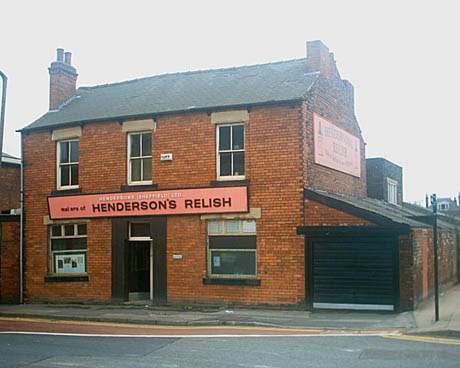
IMAGE: Henderson’s Relish factory, Sheffield, photo by Gregory Deryckère.
Henshaw: My preference is to visit the site beforehand, just so I can point people in the direction of interesting things and be a better guide.
With the Sheffield smell-walk, I knew I wanted one of the sites to be the Henderson’s Relish factory. It’s Worcester sauce’s main competitor in the UK. From the meeting point, I headed in that direction toward a nearby park that I thought it would be quite nice to include, and then I noticed that under some ordinary stairs that I’ve walked past a million times, there was this little bit that goes nowhere. I thought, “I wonder what’s down there, I’ll go and have a smell.” From above, it looked like one of those derelict spaces that you imagine homeless people would sleep in at night. It was actually very clean, apart from the fact that there were loads of cigarette ends.
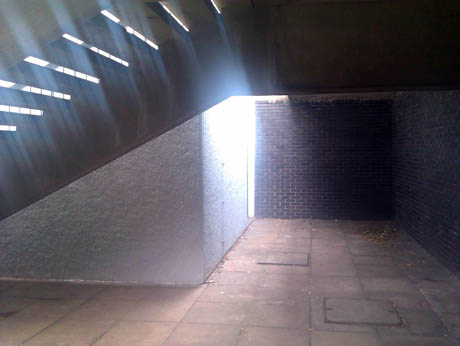
IMAGE: The space under the stairs, Sheffield (photo by Victoria Henshaw).
In Seattle, I didn’t even choose the route. I just took people on the same walk that my co-organiser, Joyce Pisnanont, who works for the Seattle Chinatown International District Preservation & Development Authority, normally goes on — except that we did it from the perspective of smell, which gives you very different insights.
Something that I’ve found is that people usually do not register the smells around them. We’d walk through an area, and, because I was asking them to focus on smell, they would say things like, “You know, that smell is very familiar — I smell it every day and I really like it, but I’ve not consciously registered that it was there before — I’ve just whizzed past.”
People get into different perceptual states with smell, as they do for the other senses as well. Barry Truax has talked about this from the point of view of acoustic ecology: people get into different mindsets as to whether they’re going to actively perceive the sounds that are around them or not.
But what was also interesting is that, actually, whether they were actively registering odours or not, smells were still clearly influencing people’s perceptions of different places.
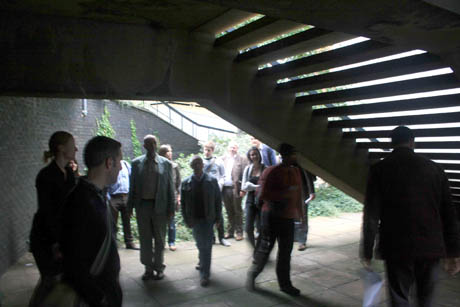
IMAGE: The smell-walkers in action, photo by Victoria Henshaw.
Edible Geography: Who comes on your smell walks?
Henshaw: The event in Sheffield was originally targeted at the Yorkshire Urban Design Group, so it was largely design professionals — urban designers, architects, town planners, and students in those fields. I organized the Seattle walk as part of the American Association of Geographers annual conference, and so, by its very nature, it was mostly geographers. But within my PhD research, I also did smell walks with local business people, residents, and people who worked in Doncaster town centre.
I also had access to a lot of data from sensory walks that had been carried out with residents of different cities across England, as part of a project called VivaCity 2020. They asked people to take photographs of their local area and then take the researcher on a ten-minute walk anywhere near where they lived. Afterward, the researcher went through each of the different senses and asked them, “How does your area look? How does your area taste? How does it sound?”

IMAGE: Doncaster smellmarks, photo by Victoria Henshaw.
Edible Geography: Have you found a difference in the kinds of things that the professional designers perceive on a smell walk, versus the residents?
Henshaw: It was quite striking how different people’s life perspectives, whether they be determined by gender or by race or by profession, all influenced the way that they perceived different odors.
Design professionals were thinking about smell in terms of managing the city. As an example, we’d often come across someone with a burger van, frying burgers and hot dogs in the street, within the heart of the town centre. The general community frequently really liked that — they’d say it reminded them of fairgrounds and good times. Those with responsibility for managing the town centre thought it was a disgusting smell, that it really lowered the tone of the area, and that it should be banished.
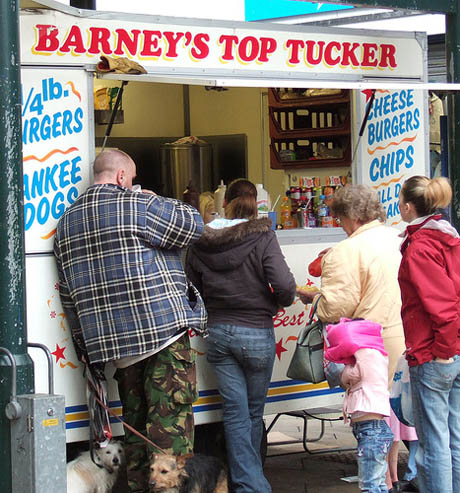
IMAGE: Burger van, by Flickr user Evissa.
Now, something surprising that came out of my research is that when I asked people to rate their own sense of smell before the walk, the female participants rated their sense of smell much higher than the male participants did. But actually, when we went out there, men and women were detecting exactly the same thing.
The literature says that women do have a slightly better sense of smell, although it’s argued by some people that that’s related to female superiority at accessing the vocabulary to name the smells. However, I found that there was really no difference in gender performance when it came to detecting smells, but that the women showed a lot more disgust toward smells. My female participants would say things like, “That’s the smell of vomit, ugh, that’s making me feel sick.” Whereas the men were much more accepting of, and much less revolted by, things.
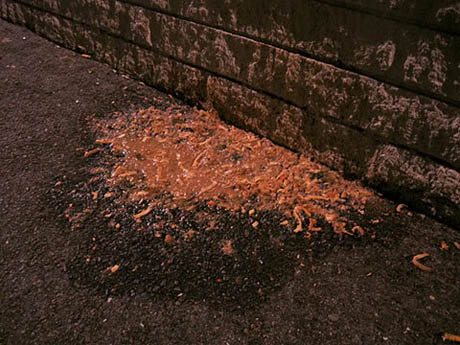
IMAGE: Street vomit, via.
Edible Geography: Is it possible that the women rated their sense of smell as better simply because their perceptual experience is stronger?
Henshaw: Absolutely. Before each walk, I asked everybody to explain their own rating of their sense of smell. In many cases, the men would explain that they thought they weren’t very sensitive to smell by saying things like, “It’s because if someone’s got body odour at the office, I don’t really notice it, but I know that Sheila, who’s at the next desk to me, she’s always saying how disgusting it is.”
Edible Geography: So they’re confusing detection and perception; just because they’re not disgusted by a smell doesn’t mean they’re not sensitive to it.
Henshaw: That’s right. I do occasional lessons in secondary schools with thirteen and fourteen year-olds and at that stage, I don’t find this difference in the self-assessment of odour performance between genders. It seems to be a socialisation of smell response that happens as people get older.
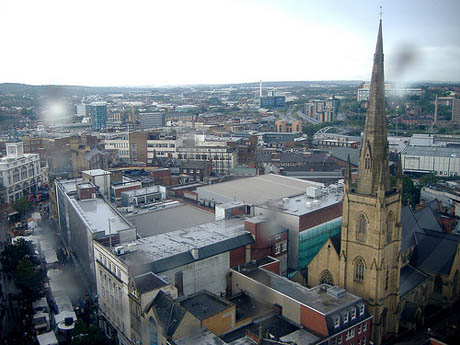
IMAGE: Sheffield panorama, photo by Flickr user meltonhill.
Edible Geography: I wonder whether that exaggerated perceptual response correlates to the idea that some places in cities aren’t safe for lone females. In other words, not being able to stand the smell of urine or vomit might be less about the quality of the odour and more about a sense of danger associated with alleys and the backs of buildings and so on.
Henshaw: Yes, absolutely. And what’s more, that association — between rundown places and spilt alcohol, urine, and vomit, or between private shopping centres and cleaning fluid, water, and coffee — held firm in people’s minds even when the actual place they were in didn’t smell like that at all. In the least liked places, people expected to be able to smell traffic fumes, and if they couldn’t detect them, they explained it away by saying the wind must be in the wrong direction.
One thing I found that was the same for professionals and members of the community was that the odours that people said they didn’t like before we set off, they often did like when they encountered that smell during the course of the walk.
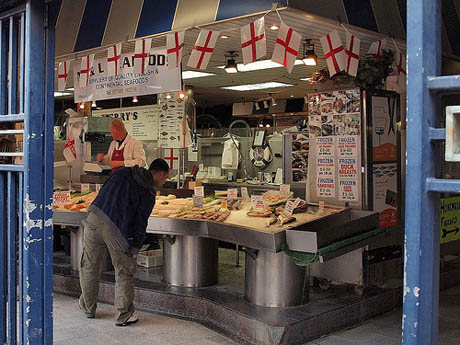
IMAGE: Doncaster fish market, via Flickr user William Thomas.
There were a lot of people who said they didn’t like the smell of fish. But Doncaster is famous for its fish market, and when we went into the fish market on the walk, even those people who said that they didn’t like the smell of fish actually enjoyed it when they experienced it within the context of the market. They expected to smell fish there — it’s a fish market, so how else would it smell? — and it enhanced their experience of the market.
In a vacuum, people say that they like and don’t like particular smells, but it turns out that they can enjoy all kinds of odours as long as they experience them in the right context. As designers, that’s quite an important point for us to note. It would be easy for us to say that because our surveys have said that people like smell A but they don’t like that smell B, therefore we’re going to design out smell B and introduce smell A everywhere. But people can enjoy a smell that they say they don’t like when it enhances their place experience.
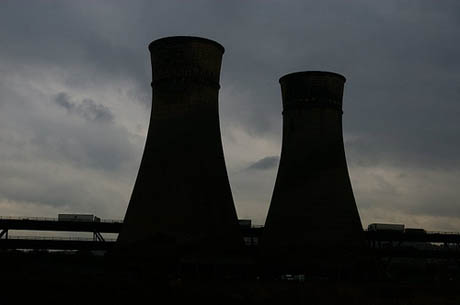
IMAGE: Sheffield’s iconic Tinsley cooling towers, photo by Flickr user underclassrising.
Edible Geography: That seems to imply that smells need to be traditional or expected to be enjoyed and to contribute to a person’s sense of place. What happens when a new smell is introduced into a city?
Henshaw: One good example of that comes from the Copley Road district, in Doncaster. Doncaster is traditionally a very working class town with very little racial mix. In the past five years, the Copley Road area specifically has seen a large influx of different ethnic minorities.
It was an interesting place to visit on my smell walks because there were the cooking odours of a lot of different ethnically-associated foods all within a small area — Thai food, Afghan cuisine, Turkish food, and so on.
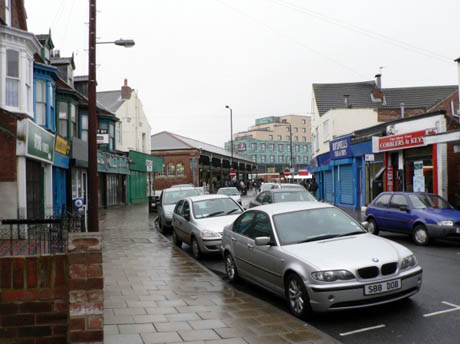
IMAGE: Copley Road, Doncaster, via.
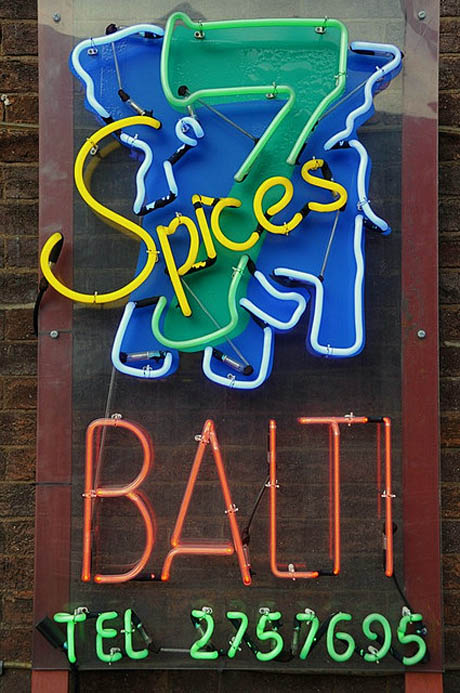
IMAGE: Sheffield balti house, photo by Flickr user Ashok.
Because this was quite a new thing to Doncaster, people came at it from two completely opposite ends of the spectrum. Some people really liked the smells and thought of them as a sign of Doncaster becoming a cosmopolitan city. Then there were a lot of people who experienced it almost as “these foreigners” polluting our traditional smellscape with their odours. Other research projects have come across this in the past — people will express racial antipathy through sensory means.
And some people expressed a kind of ambivalence toward the sensory stimuli, as if they were experiencing both responses at the same time. I did actually have some people say, “I really like this smell, it’s cosmopolitan and it’s a sign of Doncaster moving onward and upward, but it does have a feeling of being quite edgy here, and I could imagine that other people would feel threatened.” They’d talk about other people feeling threatened rather than themselves.
What’s interesting is that Copley Road’s international population is a relatively new phenomenon, whereas, for example, Manchester’s Chinatown is one of the largest and longest established in Europe. And in the sensory walk data sets from Manchester’s Chinatown, there was none of this sensory expression of racial antipathy. People said that they very much enjoyed the cooking odours — even local residents who said that the smells did become a bit strong at dinner time also admitted that they actually really liked them.
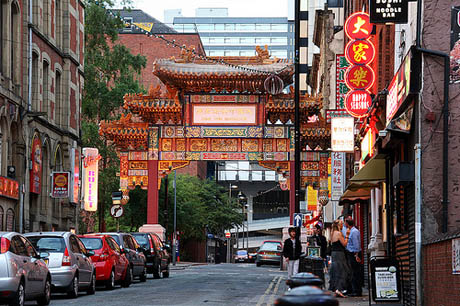
IMAGE: Manchester’s Chinatown, photo by Flickr user Emil Stefanov.
Edible Geography: I’m curious as to how you document these walks, if at all. Unlike audio or visual phenomena, smell can’t be photographed or recorded except by using prohibitively expensive headspace equipment. Given that smell is so evanescent and personal, do you create maps of your walks, or is it a purely in-the-moment experience?
Henshaw: For my PhD research, I recorded each of the interviews, and because they were each on a set route, it was easy to correlate mentions of smell to particular locations.
It’s perfectly possible to document smells with a map, although you run into some interesting challenges. One thing I ran into was how to document temporal odors. Most of my interviews were carried out during the daytime, and yet I found that people were mentioning the odours of the evening to me. They were describing the smellscape through recall rather reporting what they could detect while they were out there.
Then again, Doncaster market only operates on certain days of the week and at certain times during the day, and so sometimes we’d go to the market when it wasn’t operating and people would talk about the smell of emptiness.
Certainly, there were very clear temporal waves and shifts to the city’s smellscape. Actually, when I started the walks in January 2009, I’d originally planned to do the whole lot straight away. But I quickly realised that I needed to carry out some of the interviews in warmer weather, because there were huge differences in how people used public space based on the temperature, and that changed how the city smelled.
Across Europe, there are big differences in terms of how people use the outdoor area, depending on the general temperature. In Greece, for example, there are areas of public space that people are much more likely to use in the autumn than they are during the summer when it’s just too hot. There’s a different seasonality to the smellscape, as it were.
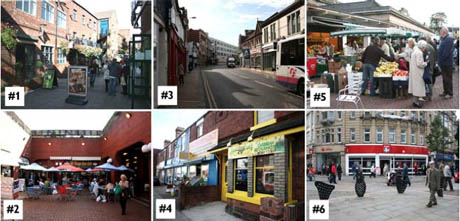
IMAGE: Doncaster smellmarks, photos by Victoria Henshaw.
Edible Geography: I’m reminded of the smell-mapping work of Sissel Tolaas, and her idea that smell is a navigational tool. Your idea of smellmarks also seems to imply that smell goes beyond augmenting place experience to communicate with and orient people.
Henshaw: The idea of a smellmark obviously comes from the idea of a landmark, and the idea that a distinctive, recurring or constant smell can act as a geographic reference point.
In soundscapes research, there’s been some discussion about identifying soundmarks. One example would be a church bell. The idea used to be that wherever you could hear the church bell, that was the community that church served. So that soundmark marked time and communicated certain events, but also delimited a physical, geographical space as well.
In the same way, I found that there were certain smells in Doncaster that people would bring up again and again and again. The fish market was one example. Another was this one particular basement restaurant in Doncaster that has a vent that releases directly onto the street from their kitchen. It’s really, really strong and you can feel the warmth of the emission as well. People talked about that quite a lot: before we actually went out walking, while we were walking, and afterward. And some people didn’t like the smell, and others really liked it, but either way, you could blindfold people and they’d know where they were if they could smell that restaurant.
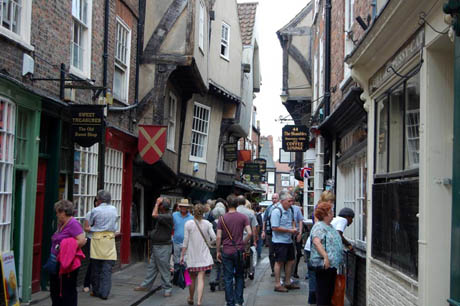
IMAGE: The Shambles, York; a well-preserved British medieval streetscape, via.
Some smellmarks were big enough to leak out of their context. For example, there’s a medieval part of town that smells of the drains all the time because it’s got such old drainage infrastructure. It really smells terrible, but it’s highly associated with that area. When it leaks out into different areas, people would detect it and say things like “I’m not sure I like that smell,” and then they’d realize it was the medieval area and then it wouldn’t be so bad, because it was in context.
One other interesting example of a smellmark was the Lush bath and body stores. They have a very strong smell, and more than a third of my smell walk participants brought them up spontaneously as a smell reference point. I also interviewed the manager of a Lush store and he said that whenever he goes to a different town, he gets off the train and he can pretty much follow his nose to the Lush store. He doesn’t need a map because he can smell it.
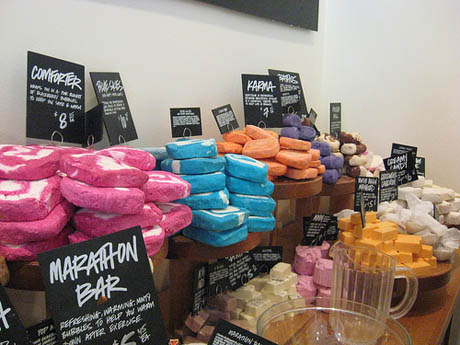
IMAGE: Lush soaps, via.
Edible Geography: Moving on from this smell-walk research to the bigger picture of the relationship between smell and cities, how is smell used in urban design? And how could or should it be used?
Henshaw: At the moment, the smell of cities is mostly an unintentional consequence of other planning decisions.
There’s a fairly recent book called Invisible Architecture, and in it, the architect Herve Ellena says that olfaction is “the dark side of architecture” — it’s the sense that people don’t think about and, as a result, the smells of architecture and of designed interior spaces come about as an unforeseen consequence.
The same is true, I’ve found, for the outdoor environment and the smell of cities. We never thought about the smells of places. We develop these huge swathes of land, and we’re removing meaningful smells and sounds and textures without even being aware of them in the first place. In the UK, we have something called listed building status, so that beautiful buildings are protected and we’re not allowed to redevelop them. But there aren’t those equivalents for beautiful sounds or beautiful smells. That makes it doubly important that designers and planners consider smell and the other senses.
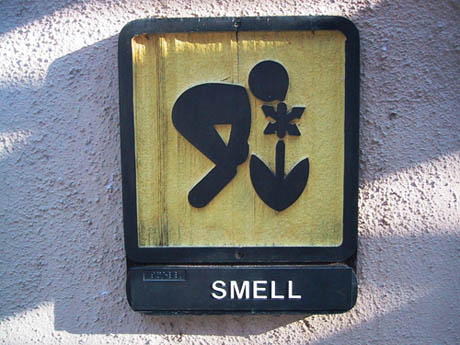
IMAGE: Smellmark signage? via Glass Petal Smoke.
In terms of actively using smell in urban design, there are strong ethical implications that I take quite seriously. What I don’t want to do is advocate for people to introduce loads of synthetic scents into public spaces, or to parachute in odours that have absolutely nothing to do with that area. At the very least, there are people’s environmental sensitivities to be considered.
When I talk to architects and planners, I tell them that there are other ways of doing this. People think that if you’re talking about designing with smell that must mean introducing synthetic odours. But when I ask people on smell walks what sort of things are influencing their smell experience, they talk about wind movement or the way water makes an area’s air quality seem better.
Typically, design professionals in the West think about the smell environment in terms of control and management: separation, deodorization, masking, and scenting. Really, though, the way we in Western society organise odours is through separation, which stems from Modernism.
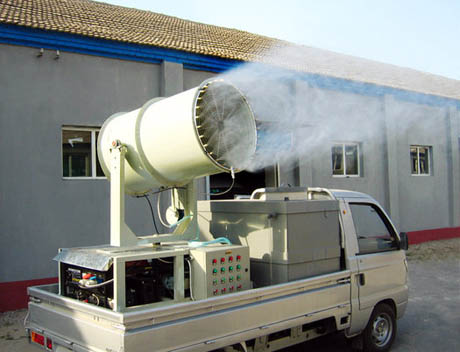
IMAGE: China’s deodorant guns pump out fragrance to cover up the smell of landfill; photo via PopSci.
Edible Geography: What are some of the tools that designers have to work with smell? How would someone look at their masterplan for say, the Olympic site in East London, and do a smell audit of it?
Henshaw: One thing I did as part of my PhD thesis was that I identified different urban design decision-making processes where the sense of smell could be incorporated in. The first one of those is around legislation and policy — the sorts of frameworks within which built environment professionals operate. There are places within that where odour would fit — for example, there’s already legislation that sets noise limits — but it’s considered in negative terms and in terms of managing a potential nuisance.

IMAGE: Overflowing rubbish bins in Leeds; photo via The Guardian.
In talking to developers, designers, and architects about where they thought that smell would best fit into the planning and building process, they felt that smell could and should be incorporated into design statements. In other words, when we produce design guidance documents within cities, they should have a clear statement of what position a local area and local communities have on the issue of smell — which could be as basic as just saying that they want odour to be considered as part of any pre-design assessment.
Now, because people can perceive odours in very different ways, this is quite a sensitive area. Certain community groups and ethnic groups, or even different genders, can feel excluded on the basis of odour. So it’s quite important that different sectors of the community be involved in assessing a site and determining whether its smells are meaningful to them. Designers can work with that input, and use the tools at their disposal — the materials used, enclosure and air movement, or the introduction of water — to create a smellscape that enhances people’s sense of place.
Some of the tools at an urban smell designer’s disposal are very down-to-earth everyday things that turn out to be quite powerful. For example, where bus stops are located is an important olfactory decision. If they are right next to large residential blocks, under people’s windows, then although there are the benefits of close access to public transport, it means that people have to keep their windows closed, particularly during the warm summer months when the fumes are especially strong.
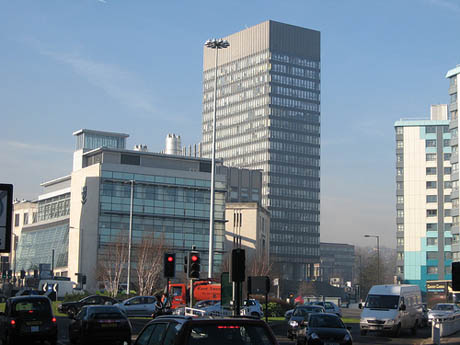
IMAGE: Sheffield traffic, photo by Flickr user Sarah Grice.
Designers who are sensitive to that can balance the importance of convenient access to public transport with the olfactory impact, and perhaps locate the bus stop outside, for example, a next-door business instead. Another issue is traffic lights on hills: cars and lorries that set off up the hill from a stop emit far more smell and fumes right where people are waiting to cross the street than they would if the traffic lights were located a little bit further up the road where it was flatter, for example.
Edible Geography: The interesting issue there is that you have contesting priorities: easy access to public transport, convenient pedestrian crossings, or improved traffic circulation are set against optimizing the smellscape. This also happens with urban trees, which are chosen to be easy to manage, but then turn out to provoke terrible asthma, for example.
Henshaw: Exactly. I used to be a town centre manager, actually, and it used to really frustrate me that the people who managed the CCTV cameras didn’t want us to have trees with decent-sized canopies because it blocked their sightlines, even though with climate change, providing urban shade is increasingly important, even in the UK.
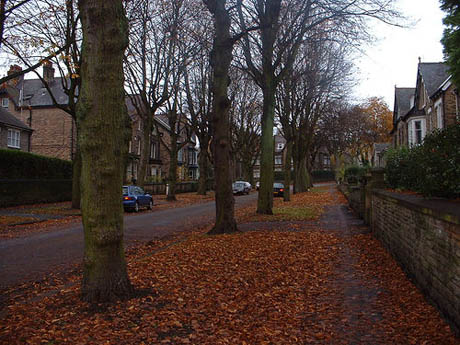
IMAGE: Fallen leaves on a Sheffield street, photo by Flickr user Girard Alexandre.
Edible Geography: Have you come across any particularly good examples of smell design in urban planning?
Henshaw: Well, in most cases, sadly, smell tends to be thought about as a consequence rather than a design objective. I think the most interesting example I’ve come across of a consciously designed urban smellscape is in Grasse, in the south of France, which is the perfume production centre of the world. Most of the jasmine for Chanel No.5 is grown in that area. And, because Grasse already has a reputation built on its smellscape, they have then tried to use urban design to emphasize that. So rather than the visual sense taking priority in the way that it does in the design of most places today, they use visual imagery to complement the existing smellscape, by using images of flowers and perfume in their public art and their sculptures. It is a bit on the tacky side, but they’ve even got a fountain at the centre of the roundabout outside their Hotel de Ville, and in the center of it they’ve got a big bottle of Chanel No.5. They’ve actually got a real perfume fountain as well, outside one of the perfume houses.
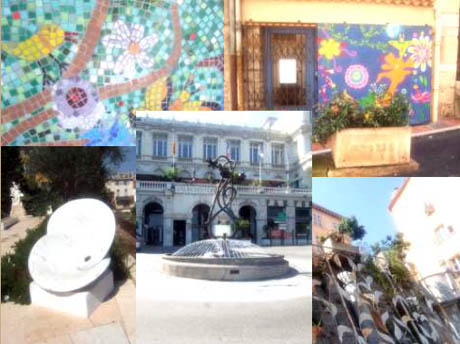
IMAGE: Floral and perfume-themed decor in Grasse, photos by Victoria Henshaw.
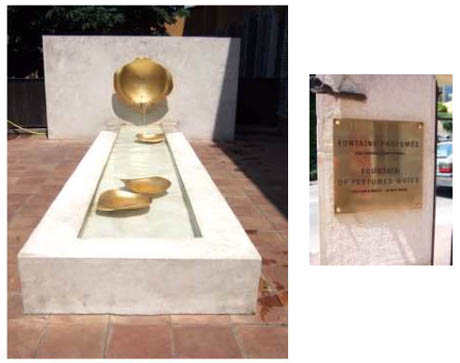
IMAGE: Perfumed fountain, Grasse, photos by Victoria Henshaw.
In any case, it is evidently something that they’ve thought about in all sorts of different ways. The town centre is like many areas in France — it’s got the traditional canyon-type footprint with tall old stone buildings and a very slim street that the traffic travels through, abutted either side by restaurants, and outside each of those they have big pots of jasmine growing. Even though you’ve got the traffic, you’re smelling the scent of the flowers, and they do absorb the sound that comes with the canyon effect as well.
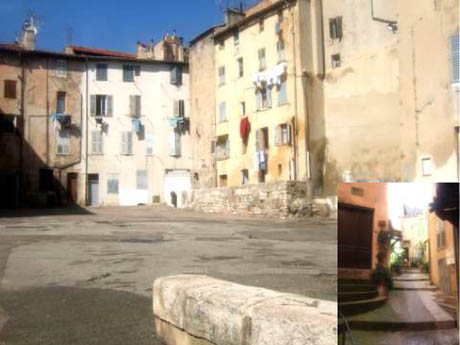
IMAGE: Grasse, photos by Victoria Henshaw.
Edible Geography: Some of what Grasse is doing is almost smell design in reverse: they’re providing visual context for a background scent that is leaking in from the surrounding countryside, to help people appreciate the smell and enhance their sense of place.
The other thing I was curious about is, given the headlines about China building new cities from scratch or Arup designing an eco-cities in South Korea, whether you’ve encountered any designers working on those kinds of projects who are consciously designing urban smell experiences?
Henshaw: I haven’t, but it is an interesting question. You’d think that if they were trying to fundamentally rethink the city to make it more sustainable, they’d expand the way they think about design to include sensory experience as well. Instead, what they’ve tended to think about is changes in lifestyle — things like having better connected cities with more public transport, pedestrian friendly environments, and local food, as well as more environmentally friendly building materials and building design. But the question of what design is — what it encompasses and what sensory experiences it should consider — aren’t being reconsidered at a foundational level.
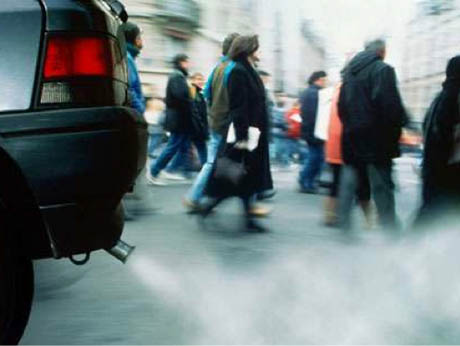
IMAGE: Car exhaust.
Edible Geography: And yet, of course, taking cars off the street will have an olfactory and an auditory effect. The lifestyle and environmental implications of these design decisions are important, but perhaps they shouldn’t exclude consideration of the sensory experience implications.
Henshaw: Exactly. Actually, I went to a conference in Manchester a couple of weeks ago on city weather. I went along because my research showed how significantly weather can influence smell experiences: how air moves around a city, how odours evaporate in different temperatures, how each season brings different behaviors and activities, how temperature inversions can trap smog — even how rain can both clean the air but also release drain smells, as well. But actually, the people who spoke at the conference were very much numbers-based — it was all about climate change and urban heat islands and extreme weather events and so on. It seems that within urban design and built environment practices in general, there are various movements that are looking at all sorts of things that relate to the sensory environment, but they’re not making that connection.
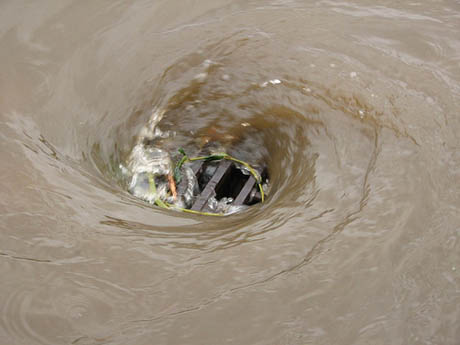
IMAGE: Sheffield storm drain, by Flickr user Tim Herrick.
The local food movement and gentrification is interesting in that regard, as well. Many of the breweries and food factories that were traditional smellmarks have now been designed out of cities. Breweries were a traditional urban industry in England, and we have brands that are associated with all the major cities — Boddingtons in Manchester, Tetley’s in Leeds, and Wards in Sheffield, and so on. All of them have now been relocated out of the cities — Tetley’s was the last one and that closed last summer. And that’s had a huge impact on the smell of those cities.
Edible Geography: The same thing is true in the eastern US. Before Prohibition there were more breweries in New York City than there are Starbucks today. They’ve all moved out of the city and the breweries have been converted to fancy lofts for the creative class — but what’s interesting is that artisanal brewers and distillers are now moving back into urban centres again, and they have their own effect on the smellscape.
Of course, as industry moved out of the city, people remember the breweries and the sweet factories nostalgically, but there were also the slaughterhouses and tanneries and meat-packing districts, and people don’t miss those smells so much.
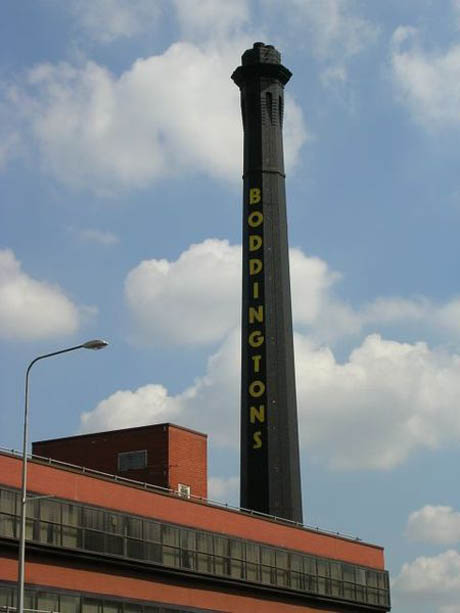
IMAGE: The Cream of Manchester is no longer made at the urban Strangeways brewery, photo via.
Henshaw: In Invisible Architecture, Barbara and Perliss do an interview in New York City’s meat-packing district, and it’s fascinating to hear how much the sensory environment has changed.
Edible Geography: It’s interesting, because designers and urban planners spend a lot of time thinking and talking about gentrification, but you don’t often come across a sensory analysis of it.
Henshaw: And that’s something that smell can communicate very strongly indeed: the sense of whether you belong in a place or not. It was something that was really clear from the responses people gave to the smells of Doncaster’s Copley Road area, and it’s something that different academics have written about in the past: that feeling that you don’t belong somewhere is something that you pick up on in very sensory terms.
There was a very interesting thing that I’ve read about that’s happened in the States, but doesn’t seem to have hit England yet, which is people from the transient community being excluded from public libraries and community centres because of the way that they smell. In terms of body odour, people are far less tolerant than they have been historically, and it’s the same with towns and cities. I think that’s something that designers have to be really careful about, because they may be using smell, even unconsciously, to exclude people.
Edible Geography: This brings us back to the ethical implications of smell design and another issue I wanted to ask you about, which was private businesses using smell to encourage certain behaviours. The most recent example I read about was a supermarket in Staten Island that was pumping out the smell of “Lindt Chocolate,” “Rosemary Focaccia,” and “Smoky Bacon,” and had seen fresh food sales go up by eight percent. And I remember reading about a new casino development in Vegas, CityCenter, that had a custom fragrance called “Essence of Destiny” pumped into its ventilation system. That world of privatised smellscapes doesn’t seem to be regulated at all — should it be?
Henshaw: A lot of people on my smell walks raise the topic of sensory manipulation. For example, it’s been reported quite widely in the media that supermarkets will pipe the smell of baking bread through ventilation systems to entice in shoppers and increase sales. And my smell walk participants frequently brought up the idea that they thought shops were trying to trick them into buying things by using different smells, and they really didn’t like the idea of it at all.
There were a couple of things that were interesting about this. One was that people drew the line between smells they thought were honest and smells they thought were dishonest in different places. A lot of people liked the scent of the high-end clothing store, but they resented the supermarket bakery smell, so perhaps it tied back to preconceived ideas about the big bad supermarket manipulating people whereas the small independent stores were thought of in much more positive terms.
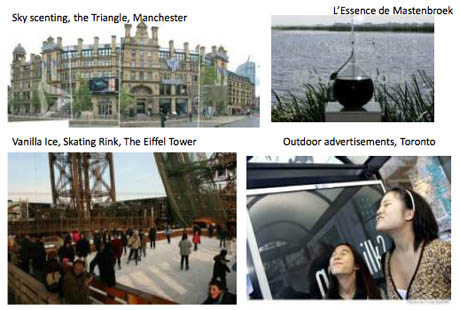
IMAGES: Examples of scenting in urban design, including the awesomely named Vanilla Ice skating rink developed by Givaudan for the Eiffel Tower in 2004. Photo collage by Victoria Henshaw.
And then some of the discomfort comes down to how people think about the sense of smell. As far back as the 1800s, vision and sound became thought of as “the noble senses,” and became more highly regarded by society than smell, touch, and taste, which were called “the chemical senses.” At the same time, the sense of smell began to be associated with women, children, older people, and ethnic minorities, as well, and it was tied up with the whole idea of witchcraft. I think that association between smell and witchcraft has lingered on in the ways people think about smell today, and the power they attribute to it to affect their behaviour without their being able to control it.
That level of suspicion, fear, and lack of control means that people think about designing with smell in a different way than they would think about design in general terms.
Edible Geography: That’s interesting, because then it’s partly a question of people just not being smell educated. It’s smell ignorance — a lack of confidence in your own ability to perceive and understand smell — that makes you fearful that you’re being manipulated in some way.
Henshaw: I like that phrase, “smell ignorance!” Also, at the end of the day, the trendiness of smell design in the service sectors and product sectors over the past few years, with the likes of Martin Lindstrom and his Brandscapes work, just serves to highlight how smell hasn’t really been thought about in the urban design world to the same extent at all.
Edible Geography: Where is your smell research going, and what are you working on now?
Henshaw: I’m definitely at the point where I want to take the knowledge I’ve gained through my research and think about ways we as designers can do something with it. I’m working with Ray Lucas at the University of Manchester, and he’s done quite a lot on sensory notation systems, for example. The most interesting question for me now is: how do we as designers go about assessing the sensory experience of sites and proactively designing to preserve and enhance that.
My wider interest now is to start considering how the senses interact — how, for example, sound influences our sense of smell, and they combine to affect how we perceive different environments. Outdoor, urban environments are my particular interest, but I’m also interested in thinking about how outdoor and indoor environments interact.
At Manchester, I’ve joined a project that is just getting started, looking at how older people sense and regulate their thermal environment. It’s partly funded by one of the big utility companies, Electricité de France, which is particularly interested in how older people understand new thermal regulation technologies. But I’ve been brought in to look at it from a sensory perspective, in terms of how the senses interact to produce that feeling of being hot or cold — the staleness of the air contributes to a feeling of uncomfortable warmth, for example. My idea is that thermal comfort is a multi-sensory phenomenon, not just a matter of the temperature on the thermostat.
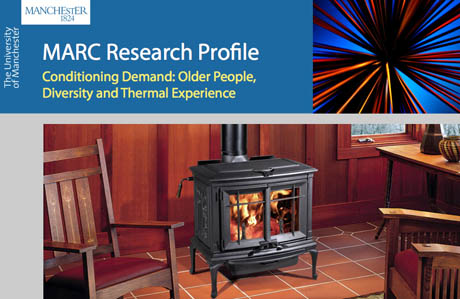
IMAGE: The University of Manchester’s Conditioning Demand research initiative.
I’ve also been working on something called the National Vibration Project [PDF], which is investigating how vibration annoys people in homes. The idea is to look at all different sorts of vibration, whether it be from construction, or adjacent motorways, or underground subway systems, and see whether people are annoyed and what factors influence their annoyance.
One of the things we found with that is that if you see your ornaments vibrating on a mantelpiece, you’re far more likely to be annoyed by the vibration than you are if you just felt it. Somehow experiencing it through that additional sensory means makes it much more annoying. And vibration is by its very nature felt through multiple sensory means: it’s sound that you feel in a tactile way.
In fact, this is something that people don’t usually realize, but the experience of smell is also inherently multi-sensory. It’s experienced not just through our olfactory receptors, but also through our trigeminal nerve, which is a tactile nerve in our faces. I’m writing something about it myself, because it’s barely been discussed in the sensory literature. With odours like petrol and nail varnish remover and paint, you get a tingly sensation in your face — and that’s your trigeminal nerve sensing that smell. Smells like cinnamon, petrol, and acetone produce a lot of trigeminal sensation.
Interestingly, we’re less likely to like trigeminal smells than any other kind of smell — it’s the only inbuilt shared smell preference humans have. In the sixties and seventies, scientists wafted swabs of trigeminally-associated smells in front of babies, and they all pulled horrible faces of disgust. In adults, disgust is a social, learned response, but it’s also a physical reaction — we pull a particular face to try to limit the amount of air that we let into our bodies through our noses.
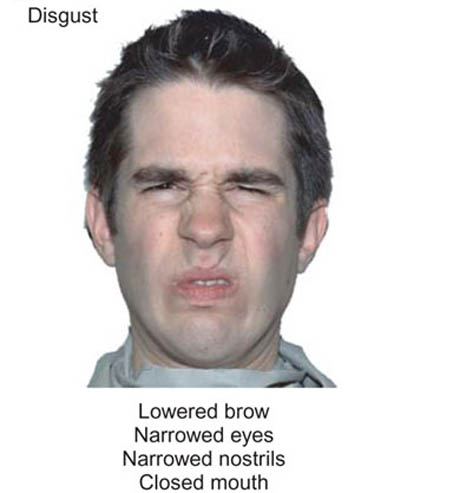
IMAGE: Disgust face, via.
Edible Geography: So the experience of cinnamon is always both tactile and olfactory. But it seems as though a lot of urban sensory experience is inherently multi-sensory. I’m reminded of your smellmark restaurant vent, or architectural historian David Gissen’s exploration of dankness or dust, which are visual, olfactory, and tactile environments, and can even muffle or distort sound.
Henshaw: When I started my research, I was actually really uncomfortable about trying to separate smell from sensory experience. Clearly, we experience cities through the interaction of all of our senses, and in any case, the five senses are a social creation — different cultures divide the senses up in different ways. But actually, we know so little about the sense of smell that you almost have to focus just on that and try to build up a body of knowledge to work from.
Even within my smell research, though, I couldn’t help but encounter overlaps. For example, we were talking about the medieval area of Doncaster and how it smells pretty bad due to the drains — and, in fact, the sound environment was usually experienced as quite negative, because it’s got that medieval canyon footprint that amplifies the sound of traffic. But the visual aesthetic of the beautiful old buildings more than made up for the olfactory and auditory negatives, and the place is quite liked. The combination and variety between the sensory experiences actually seems to heighten people’s enjoyment of place.
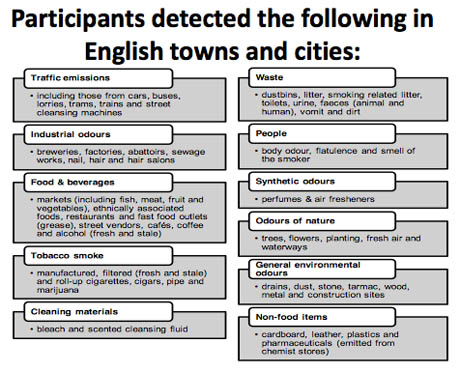
IMAGE: List of smells detected in English towns and cities by participants in Victoria Henshaw’s smell-walking studies.
There was a very interesting study done by a couple of academics, Dann and Jacobsen, who examined any mention of the smell of different places in the descriptions of independent travel writers, all the way back to the 1800s. They found all sorts of interesting trends, including the fact that towns were consistently talked about in much more negative terms than rural areas, but their conclusion was that cities should really try to design out all the negatively perceived smells and should reintroduce more positively perceived smells.
Now, my issues with that recommendation would be, first of all, different people’s ideas of unpleasant smells vary quite dramatically, so if you’re just designing based on the smell preferences of a particular group of people with more powerful voices, then you could end up with a highly exclusive environment. And, as the example of Doncaster’s medieval area shows, a smell that would be negatively perceived in isolation can actually contribute to a positive place experience.
As designers, I think it’s really important to note that not all aspects of sensory perception in an area have to be positive. That’s actually something I’d be interested in doing in the future: developing a guide to different sorts of areas and the different sensory profiles they can have. That’s something that could be both used to manage and understand existing areas, but also as developers work on new developments, they could be conscious of the sensory profile that is best suited to the kind of place experience they’re trying to create.
The idea of a sensory profile would also give you a nice framework for interdisciplinary thinking. There’s a real need now for all the disciplines — acousticians, urban planners, perfumers, and micro-meteorologists — to start thinking in cross-cutting ways to pull this all together. Most designers don’t have time to dig into all the research, they just need tools that are going to make it easy for them to consider these issues in their day-to-day practice.
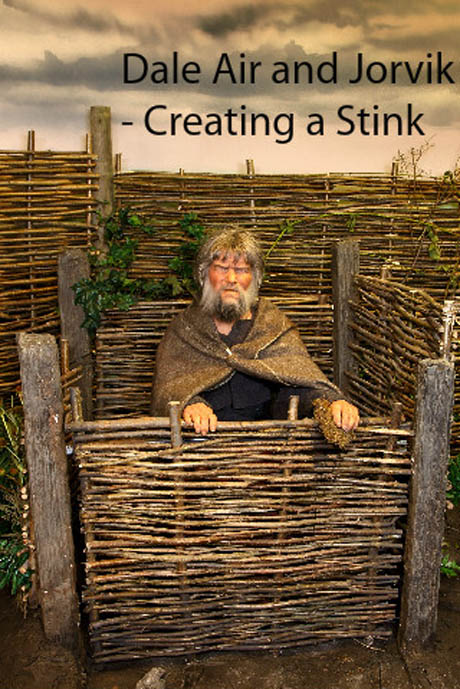
IMAGE: Dale Air are the official aroma suppliers to Jorvik Viking Centre, who offer the following testimonial: “Our relationship with Dale Air, from the beginning, has made the smell experience at Jorvik one of the most unique memories for the Jorvik visitor.”
Edible Geography: And, of course, negatively perceived smells have their own historical value and future uses. I like the idea of smell preservation and smell tourism — the idea that smell reconstruction can be an important aspect of visiting a historic site, for example. There’s an extremely interesting example of Jorge Otero-Pailos attempting to recreate the smell of Philip Johnson’s Glass House at different points during its inhabitation. A better known, if far cheesier, example is Jorvik Viking Centre, which I think every kid in England visits at some point or another. The overwhelming experience there is how bad it smells — it’s a smell recreation as a historical experience.
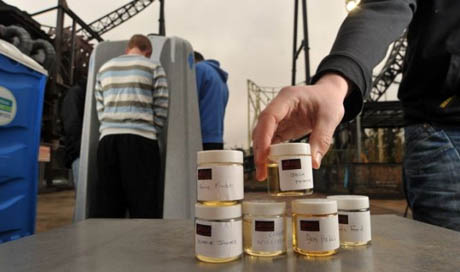
IMAGE: Urine samples being donated at Thorpe Park, via.
Henshaw: Thorpe Park introduced a new visitor attraction based on The Saw last year, and they did a huge search for the smelliest urine in England. They’ve recreated it and used it in the ride to enhance the experience of horror. The funny thing about that is that it’s an experience that people pay a lot of money for.
The idea of smell preservation also reminds me of what’s happened to the traditional English pub. Now that tobacco legislation has moved all the smokers outside, pubs have started to smell of body odour, urine, stale beer — all those sorts of things, instead. A lot of people on my smell walks really mourned the smell of the traditional English pub. Smoke was a large part of it, but really all those odours combined together to create this unique mix — the smell of the English pub — which people perceived as a comforting odour. And now it’s gone. It’s not that people don’t perceive the health benefits, but they do miss that smell.
What was interesting was that a lot of my smell walkers talked to me about how they are actually more annoyed now by experiencing cigarette smoke in the street than they were by it in the pubs, because in the pubs it was expected to be in there and it belonged, and they don’t think it belongs in the street in the same way. That seems to be part of the current mindset: we’ve sanitized our urban environments to such a degree that any experience that’s out of our control, we automatically react negatively to it.
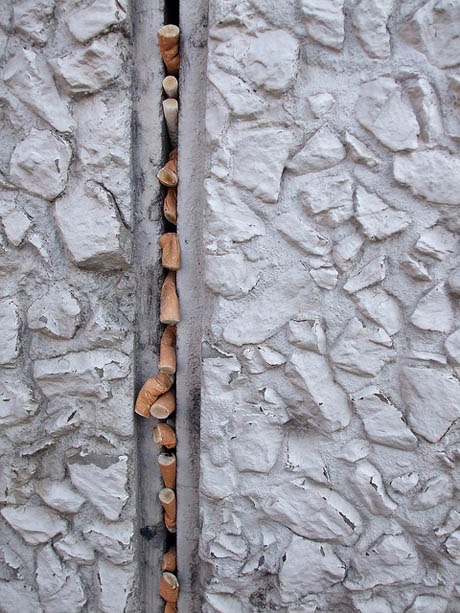
IMAGE: Cigarette butts in Sheffield, photo by Flickr user Philippa Willitts.
Edible Geography: The relationship between cigarettes and pubs also illustrates an interesting property of smell, which is that you carry it with you, even after leaving a place. As a non-smoker, I quite liked the smell of cigarette smoke in pubs, but I hated that when I got home, my hair and my clothes stank.
Henshaw: That’s true. One of the unexpected effects of the smoking legislation is that the English dry-cleaning industry really took a massive hit!
[Many thanks to Victoria Henshaw for this inspiring conversation. More smell coverage on Edible Geography: “The Scent of Climate Change,” “Talking Nose,” “Ginger Biscuits and Deodorant Guns,” and “You Are Here.”]

